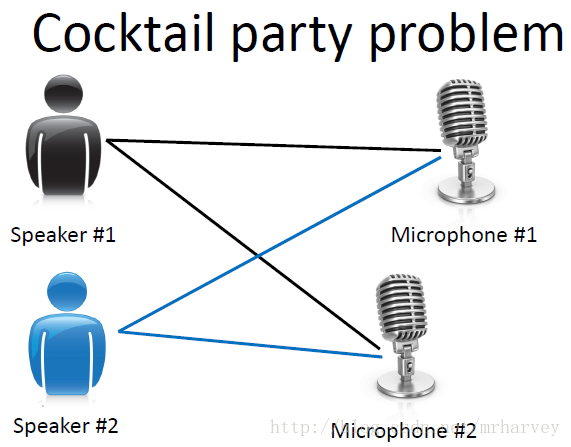“鸡尾酒会问题”(cocktailparty problem)是在计算机语音识别领域的一个问题,当前语音识别技术已经可以以较高精度识别一个人所讲的话,但是当说话的人数为两人或者多人时,语音识别率就会极大的降低,这一难题被称为鸡尾酒会问题。
该问题描述的是给定混合信号,如何分离出鸡尾酒会中同时说话的每个人的独立信号。当有N个信号源时,通常假设观察信号也有N个(例如N个麦克风或者录音机)。该假设意味着混合矩阵是个方阵,即J = D,其中D是输入数据的维数,J是系统模型的维数。
要分离出鸡尾酒会中同时说话的每个人的独立信号,常用的方法是盲信号分离算法。

1 盲信号分离
1.1 简介
盲信号(BlindSource Separation,BSS)分离指的是从多个观测到的混合信号中分析出没有观测的原始信号。通常观测到的混合信号来自多个传感器的输出,并且传感器的输出信号独立性(线性不相关)。盲信号的“盲”字强调了两点:1)原始信号并不知道;2)对于信号混合的方法也不知道。
1.2 原理(简单的数学描述)
为了简单易懂,我们先看看只有两个信号源的情况,即观测信号也是只有两个。 和 是两个源信号; 和 是两个观测信号; 和 是对声源信号 和 的估计。矩阵A是混合矩阵(说得有点别扭,混合矩阵就是将两个信号混合在一起,然后产生输出两个观测信号)。W是权重矩阵(用于提取估计出声源信号)。下面就是BSS算法的主要流程图。

图1 BSS算法主要流程图
下面是图1所示流程的,矩阵表达形式:

图2 BSS算法主要流程方程形式
看完简单的,我们看看难一点的,盲信号分离的模型。
具有n个独立的信号源 和n个独立的观察量
和n个独立的观察量 ,观察量和信号源具有如下的关系:
,观察量和信号源具有如下的关系:

其中 ,
,  , A是一个
, A是一个 的系数矩阵,原问题变成了已知
的系数矩阵,原问题变成了已知 和
和 的独立性,求对 的估计问题。
的独立性,求对 的估计问题。
假定有如下公式

其中 是对
是对 的估计,W是一个
的估计,W是一个 系数矩阵,问题变成了如何有效的对矩阵W做出估计。
系数矩阵,问题变成了如何有效的对矩阵W做出估计。
因此,BSS的主要工作是寻找一个线性滤波器或者是一个权重矩阵W。理想的条件下,W矩阵是A矩阵的逆矩阵。
由于参数空间不是欧几里得度量,在大多的情况下都是黎曼度量,因此对于W矩阵的求解选用自然梯度解法。
1.3 自然梯度法计算W矩阵
自然梯度法的计算公式为:

其中W为我们需要估计的矩阵。 为步长,
为步长, 是一个非线性变换,比如
是一个非线性变换,比如
实际计算时y为一个 矩阵,m为原始信号个数,k为采样点个数
矩阵,m为原始信号个数,k为采样点个数
计算步骤:
1)初始化W(0)为单位矩阵;
2)循环执行如下的步骤,直到W(n+1)与W(n)差异小于规定值 (计算矩阵差异的方法可以人为规定),有时候也人为规定迭代次数;
(计算矩阵差异的方法可以人为规定),有时候也人为规定迭代次数;
3)利用公式 ,(其中
,(其中  );
);
4)利用公式  ;
;
2 程序实现
1.main.m
% fftproject.m
% By: Johan Bylund(原始作者)
% 修改注释:Harvey
close all;
clear, clf, format compact;
% Makes a matrix out of wav files in project directory.
% The arreys will all be in the same length as the shortest one.
% Files longer than the shortest one will be truncated.
disp('Reading .wav files from project directory');
mic_1=wavread('000100100mix2.wav'); %Reading file from right microphone.
mic_2=wavread('000100100mix1.wav'); %Reading file from left microphone.
size(mic_1)
size(mic_2)
% The below operation makes them 1xN:
% 将矩阵设置成1*N的矩阵就一行多列的矩阵
mic_1=mic_1';
mic_2=mic_2';
% 规范长度,将长度统一在一起
if length(mic_1)>length(mic_2)
mic_1=mic_1(1:length(mic_2));
else
mic_2=mic_2(1:length(mic_1));
end
size(mic_1)
size(mic_2)
% 分别播放两个原始的接受源信号
disp('Playing the recording of the right microphone (closer to music)');
soundsc(mic_1)
disp('Playing the recording of the left microphone (closer to me)');
soundsc(mic_2)
subplot(2,1,1)
plot(mic_1), axis([0 16000 -0.12 0.12]);
title('Right microphone (closer to music)')
xlabel('Sampled points');
subplot(2,1,2)
plot(mic_2), axis([0 16000 -0.12 0.12]);
title('Left microphone (closer to me)')
xlabel('Sampled points');
% I also choose to look at the frequency spectra of the signal:
% 信号频谱经过快速傅立叶变换显示
Fs=8000; % Sampling frequency
% Matrix with the frequency spectra from the two microphones:
fftsounds=[real(fft(mic_1,Fs));real(fft(mic_2,Fs))];
f=[1:Fs/2];
figure(2)
subplot(2,1,1)
plot(f,fftsounds(1,f)), axis([0 4000 -15 15]);
title('Frequency spectra of the right microphone')
xlabel('Frequency (Hz)');
subplot(2,1,2)
plot(f,fftsounds(2,f)), axis([0 4000 -15 15]);
title('Frequency spectra of the left microphone')
xlabel('Frequency (Hz)');
% At first I tried the algorithm in the time domain, and it didn't
% manage to separate the two sources very well.
% After that I used the frequency spectra of the two microphone signals
% in the algorithm and it worked out much better.
% 算法开始了……
% 按照原作者说的话,使用频域来运算的效果会比时域要好(请看上面的英文注释)
sounds=[real(fft(mic_1));real(fft(mic_2))];
% N="number of microphones"
% P="number of points"
[N,P]=size(sounds) % P=?, N=2, in this case.
permute=randperm(P); % Generate a permutation vector.
s=sounds(:,permute); % Time-scrambled inputs for stationarity.
x=s;
mixes=sounds;
% Spheres the data (normalisation).
mx=mean(mixes');
c=cov(mixes');
x=x-mx'*ones(1,P); % Subtract means from mixes.
wz=2*inv(sqrtm(c)); % Get decorrelating matrix.
x=wz*x; % Decorrelate mixes so cov(x')=4*eye(N);
w=pi^2*rand(N); % Initialise unmixing matrix.
M=size(w,2); % M=N usually
sweep=0; oldw=w; olddelta=ones(1,N*N);
Id=eye(M);
% L="learning rate, B="points per block"
% Both are used in sep.m, which goes through the mixed signals
% in batch blocks of size B, adjusting weights, w, at the end
% of each block.
%L=0.01; B=30; sep
%L=0.001; B=30; sep % Annealing will improve solution.
%L=0.0001; B=30; sep % ...and so on
%for multiple sweeps:
L=0.0001; B=30;
for I=1:100
sep; % For details see sep.m
end;
uu=w*wz*mixes; % make unmixed sources
% Plot the two separated vectors in the frequency domain.
figure(3)
subplot(2,1,1)
plot(f,uu(1,f)), axis([0 4000 -22 22]);
title('Frequency spectra of one of the separated signals')
xlabel('Frequency (Hz)');
subplot(2,1,2)
plot(f,uu(2,f)), axis([0 4000 -22 22]);
title('Frequency spectra of the other separated signal')
xlabel('Frequency (Hz)');
% Transform signals back to time domain.
uu(2,:)=real(ifft(uu(2,:)));
uu(1,:)=real(ifft(uu(1,:)));
disp('Playing the first of the separated vectors');
soundsc(uu(1,:))
% Plot the vector that is played above.
figure(4);
subplot(2,1,1)
plot(uu(1,:)), axis([0 16000 -0.12 0.12]);
title('Plot of one of the separated vectors (time domain)')
disp('Playing the second of the separated vectors');
soundsc(uu(2,:))
% Plot the vector that is played above.
subplot(2,1,2)
plot(uu(2,:)), axis([0 16000 -0.12 0.12]);
title('Plot of the other separated vector (time domain)')
2. sep.m
% SEP goes once through the scrambled mixed speech signals, x
% (which is of length P), in batch blocks of size B, adjusting weights,
% w, at the end of each block.
%
% I suggest a learning rate L, of 0.01 at least for 2->2 separation.
% But this will be unstable for higher dimensional data. Test it.
% Use smaller values. After convergence at a value for L, lower
% L and it will fine tune the solution.
%
% NOTE: this rule is the rule in our NC paper, but multiplied by w^T*w,
% as proposed by Amari, Cichocki & Yang at NIPS '95. This `natural
% gradient' method speeds convergence and avoids the matrix inverse in the
% learning rule.
sweep=sweep+1; t=1;
noblocks=fix(P/B);
BI=B*Id;
for t=t:B:t-1+noblocks*B,
u=w*x(:,t:t+B-1);
w=w+L*(BI+(1-2*(1./(1+exp(-u))))*u')*w;
end;
sepout3. sepout.m
% SEPOUT - put whatever textual output report you want here.
% Called after each pass through the data.
% If your data is real, not artificially mixed, you will need
% to comment out line 4, since you have no idea what the matrix 'a' is.
%
[change,olddelta,angle]=wchange(oldw,w,olddelta);
oldw=w;
fprintf('****sweep=%d, change=%.4f angle=%.1f deg., [N%d,M%d,P%d,B%d,L%.5f] \n',...
sweep,change,180*angle/pi,N,M,P,B,L);
% w*wz*a %should be a permutation matrix for artif. mixed data
上述代码中所使用的声音文件可以到这个网址下下载:http://research.ics.aalto.fi/ica/cocktail/cocktail_en.cgi
参考文献
[1]维基百科. 独立成分分析. http://zh.wikipedia.org/wiki/%E7%8B%AC%E7%AB%8B%E6%88%90%E5%88%86%E5%88%86%E6%9E%90,2014-1-14.
[2] 我爱公开课. Coursera公开课笔记: 斯坦福大学机器学习第一课“引言(Introduction)”. http://52opencourse.com/54/coursera%E5%85%AC%E5%BC%80%E8%AF%BE%E7%AC%94%E8%AE%B0-%E6%96%AF%E5%9D%A6%E7%A6%8F%E5%A4%A7%E5%AD%A6%E6%9C%BA%E5%99%A8%E5%AD%A6%E4%B9%A0%E7%AC%AC%E4%B8%80%E8%AF%BE-%E5%BC%95%E8%A8%80-introduction,2014-1-14.
[3]维基百科. 盲信号分离. http://zh.wikipedia.org/wiki/%E7%9B%B2%E4%BF%A1%E5%8F%B7%E5%88%86%E7%A6%BB,2014-1-14.
[4]Johan Bylund. A hunble attempt to solvethe “Cocktail-party” problem Using Blind Source Separation[EB].http://www.vislab.uq.edu.au/education/sc3/2001/johan/johan.pdf.


评论记录:
回复评论: